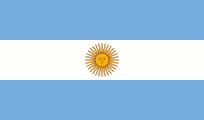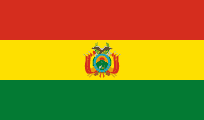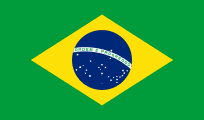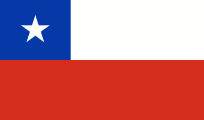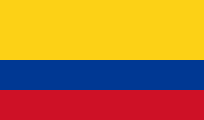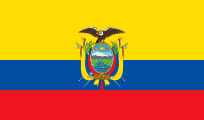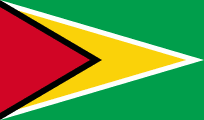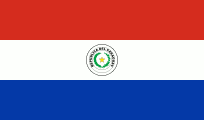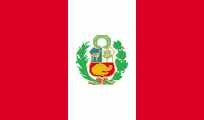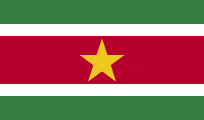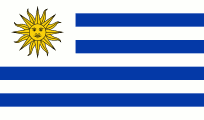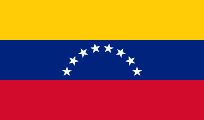Difference between revisions of "Civilisation/World Geography - South America"
(added f) |
(Added flags and information tables) |
||
| Line 388: | Line 388: | ||
Montevideo is served by Carrasco International Airport | Montevideo is served by Carrasco International Airport | ||
| − | Venezuela | + | == Venezuela == |
[[File:Flag-of-Venezuela.png|none|thumb]] | [[File:Flag-of-Venezuela.png|none|thumb]] | ||
An eighth star was added to the flag of Venezuela in 2006 | An eighth star was added to the flag of Venezuela in 2006 | ||
| Line 416: | Line 416: | ||
Pico Humboldt is the second highest peak in Venezuela | Pico Humboldt is the second highest peak in Venezuela | ||
| − | + | == Overseas territories == | |
| + | |||
| + | === French Guiana === | ||
| + | Officially called Guiana. An overseas department and region of France, on the north Atlantic coast of South America. A large part of the department's economy derives from the presence of the Guiana Space Centre, now the European Space Agency's primary launch site near the equator, at Kourou | ||
Devil’s Island is the smallest and northernmost island of the three Iles du Salut located off the coast of French Guiana | Devil’s Island is the smallest and northernmost island of the three Iles du Salut located off the coast of French Guiana | ||
| + | |||
| + | Cayenne is the capital city | ||
| + | |||
| + | == Falkland Islands == | ||
| + | The islands took their English name from Falkland Sound, the channel between the two main islands, which was in turn named after Anthony Cary, 5th Viscount Falkland by Captain John Strong, who landed on the islands in 1690 | ||
| + | |||
| + | Mount Pleasant airport serves the Falklands | ||
| + | |||
| + | Port Stanley was renamed Puerto Argentino, briefly, in 1982 | ||
| + | |||
| + | Pebble Island is one of the Falkland Islands | ||
| + | |||
| + | Mount Usborne – highest point on Falkland Islands | ||
| + | |||
| + | === South Georgia and the South Sandwich Islands === | ||
| + | British overseas territory in the southern Atlantic Ocean | ||
| + | |||
| + | Grytviken is the principal settlement of South Georgia | ||
| + | |||
| + | King Edward Point is the capital | ||
| + | |||
| + | Mount Paget on South Georgia is the highest peak in any territory under the sovereignty of the United Kingdom | ||
| + | |||
| + | Mount Asphyxia forms the summit of Zavodovski Island, northernmost of the South Sandwich Islands | ||
| + | |||
| Line 612: | Line 640: | ||
Other islands | Other islands | ||
| − | |||
| − | |||
| − | |||
| − | |||
| − | |||
| − | |||
| − | |||
| − | |||
| − | |||
Revision as of 16:08, 20 June 2021
Argentina
Flag of Argentina was created by Manuel Belgrano in 1812. Features the Sun of May that is a national emblem of Argentina and Uruguay
| Capital | Buenos Aires |
| Largest cities | Buenos Aires, Cordoba, Rosario |
| Currency | Peso |
| Highest point | Aconcagua |
Argentina is the eighth-largest country in the world, the second-largest in Latin America, and the largest Spanish-speaking one. The country has its roots in Spanish colonization of the region beginning in 1512. Argentina rose as the successor state of the Viceroyalty of the Río de la Plata. a Spanish overseas colony founded in 1776
Buenos Aires is served by Ministro Pistarini International Airport
Buenos Aires is known as “Paris of the South”. Spanish seaman Juan Diaz de Solís was the first European to reach the Río de la Plata, in 1516, but his expedition was cut short by an attack in which he was killed by the native Charrúa or Guaraní tribe. The city was first founded as the 'city of Good Air' (old Spanish for 'Fair Winds’) in 1536 by a Spanish gold-seeking expedition under Pedro de Mendoza
Buenos Aires was originally named City of the Holy Trinity and Port of Saint Mary of the Fair Winds
Ushuaia in Tierra del Fuego is the most southerly city in the world
Perito Moreno is a glacier in Patagonia
Aconcagua is the highest mountain (22,800’) outside of the Himalayas, in the province of Mendoza
Mendoza produces 70% of the wine from Argentina
Laguna del Carbon (Spanish: Coal Lagoon) is an endorheic salt lake in Argentina. At 105 metres (344 ft) below sea level, it is the lowest point of both the Western and Southern hemispheres
Straits of Magellan are between Argentina and Tierra del Fuego
Bolivia
| Capital | La Paz (see note below) |
| Largest cities | Santa Cruz, El Alto, La Paz |
| Currency | Boliviano |
| Highest point | Nevado Sajama |
Note: La Paz is the seat of government. Sucre is the constitutional capital
Boliviia is named after Simon Bolívar
Sucre is the constitutional capital of Bolivia
In the late 19th century, an increase in the world price of silver brought Bolivia relative prosperity and political stability. During the early 20th century, tin replaced silver as the country's most important source of wealth
Potosi was the major supply of silver for Spain during the period of the New World Spanish Empire
The US Geological Service estimates that Bolivia has 5.4 million cubic tonnes of lithium which represents 50% – 70% of world reserves
Salar de Uyuni is the world's largest salt flat. It is located in southwest Bolivia
Tiwanaku is an important Pre-Columbian archaeological site in western Bolivia. Tiwanaku is recognized by Andean scholars as one of the most important precursors to the Inca Empire
Brazil
Flag of Brazil features a blue disc with 27 stars and the motto "Ordem e Progresso" (‘Order and Progress’)
| Capital | Brasilia |
| Largest cities | Sao Paulo, Rio de Janeiro, Salvador, Brasilia |
| Currency | Real |
| Highest point | Pico da Neblina |
Brazil is the world's fifth largest country, both by geographical area and by population. It is the largest Portuguese-speaking country in the world. It borders all other South American countries except Ecuador and Chile and occupies 47% of the continent of South America. The country's economy is the seventh largest by GDP. Brazil has been the world's largest producer of coffee for the last 150 years
The name of Brazil is shortened from Terra do Brasil "land of brazilwood"
Rio de Janeiro was the capital of Portugal in the 19th century
Corcovado, meaning ‘hunchback’ in Portuguese, is a mountain in central Rio de Janeiro. It is known worldwide for the 38-meter (125 ft) statue of Jesus atop its peak, entitled ‘Christ the Redeemer’
Sugarloaf Mountain (in Portuguese, Pao de Acucar), is a peak situated in Rio de Janeiro, at the mouth of Guanabara Bay
Ipanema is a district of Rio de Janeiro
Rocinha is the largest favela in Rio and in Brazil
Rio de Janeiro International Airport is named after songwriter Tom Jobim
Petropolis was the official capital of the state of Rio de Janeiro between 1894 and 1903
Tijuca Forest is a mountainous hand-planted rainforest in the city of Rio de Janeiro. It is the world's largest urban forest
President Kubitschek ordered the construction of Brasilia, enacting a long-forgotten article of the country's republican constitutions stating that the capital should be relocated from Rio de Janeiro. Its main urban planner was Lucio Costa. Oscar Niemeyer was the chief architect of most of the public buildings and Roberto Burle Marx was the landscape designer. The city plan was based on the ideas of Le Corbusier. Brasília was built in 41 months, from 1956 to 1960, when it was officially inaugurated
Brasilia is laid out in the form of an airplane
The Cathedral of Brasília in the capital of the Federative Republic of Brazil is an expression of the architect Oscar Niemeyer. This concrete-framed hyperboloid structure, seems with its glass roof to be reaching up, open, to heaven
The Juscelino Kubitschek Bridge, also known as the JK Bridge, crosses Lake Paranoá in Brasília. It is named for Juscelino Kubitschek de Oliveira, former president of Brazil. It was designed by architect Alexandre Chan and structural engineer Mário Vila Verde. Chan won the Gustav Lindenthal Medal for this project
Sao Paulo is the largest city in Southern hemisphere and in Latin America. The name of the city honours Saint Paul of Tarsus
Salvador is the capital of the state of Bahia. Until 1763, Salvador was the capital of Brazil
Fortaleza is the fifth largest city in Brazil
Santos is a coffee-exporting port
Manaus is the largest city along the Amazon River
Opera house in Manaus was built in 1896
Londrina is a city in Parana state
Natal is the capital city of Rio Grande do Norte, a northeastern state in Brazil. It was founded on 25 December 1599
Recife is a major port on the Atlantic Ocean. The name Recife means ‘reef’ in Portuguese
Marajo is an island located at the mouth of the Amazon River. It is the largest island to be completely surrounded by freshwater in the world
Fordlandia is a now-abandoned, prefabricated industrial town established in the Amazon Rainforest in 1928 by American industrialist Henry Ford for the purpose of securing a source of cultivated rubber for the automobile manufacturing operations of the Ford Motor Company
Curitiba is the capital and largest city of Parana
Brazil has largest Japanese population outside of Japan
Pantanal is a natural region encompassing the world's largest tropical wetland area. It is located mostly within the Brazilian state of Mato Grosso do Sul
Sao Francisco is the longest river entirely in Brazil
Brazil has the largest Arabic diaspora
Brazil is the only country on the Tropic of Capricorn and the Equator
Chile
| Capital | Santiago |
| Largest cities | Santiago, Valparaiso, Concepcion |
| Currency | Peso |
| Highest point | Ojos del Salado |
Chile declared its independence from Spain in 1818
Santiago was founded by conquistadors in 1541
Gran Torre Santiago is a 64-story tall skyscraper in Santiago. It is the tallest building in Latin America
Chilean territory includes the Pacific islands of Juan Fernandez, Salas y Gomez, Desventuradas, and Easter Island in Oceania
The Mapocho River flows from the Andes Mountains onto the west and divides Chile's capital Santiago in two
Chile is world’s largest exporter of copper
Casablanca valley is in Chile
Loa is the longest river in Chile
Punta Arenas (English: ‘Sandy Point’) is the capital city of Chile's southernmost region, Magallanes and Antartica Chilena
Puyehue and Cordon Caulle are two coalesced volcanic edifices that form a major mountain massif in Puyehue National Park in the Andes of Ranco Province, Chile. Erupted in 2011
Nevado Ojos del Salaro is a massive stratovolcano in the Andes on the Argentina-Chile border and the highest volcano in the world at 6893 metres. It is also the second highest mountain in the Western Hemisphere and Southern Hemisphere and the highest in Chile
Cape Froward in Chile is the southernmost point in mainland South America
Cape Horn is named after the city of Hoorn in the Netherlands
Colombia
| Capital | Bogota |
| Largest cities | Bogota, Cali, Medellin |
| Currency | US dollar |
| Highest point | Pico Cristobal Colon (see note below) |
Note: Pico Simon Bolivar has almost the same elevation as Pico Cristobal Colon
Colombia is derived from the last name of Christopher Columbus
Bogota has been called "The Athens of South America”
Gold Museum (Spanish: El Museo del Oro) in Bogota displays the largest pre-Hispanic gold work collection in the world
Cali is the second largest city of Colombia
Medellin is the third largest city of Colombia
Punta Gallinas in Colombia is the northernmost point in mainland South America WikiMiniAtlas
Nevado del Ruiz is a stratovolcano in Colombia. Eruptions often cause massive lahars
Pico Cristobal Colon is named after Christopher Columbus
Ecuador
Coat of arms on the flag of Ecuador features a condor over Chimborazo
| Capital | Quito |
| Largest cities | Guayaquil, Quito |
| Currency | US dollar |
| Highest point | Chimborazo |
Ecuador takes its name from Spanish for ‘equator’
At an elevation of 2,800 meters above sea level, Quito is the highest official capital city in the world
Cotapaxi is the world’s highest active volcano
Chimborazo is a currently inactive stratovolcano located in the Andes. With a peak elevation of 6268 m, Chimborazo is the highest mountain in Ecuador. It is the highest peak in close proximity to the equator. While Chimborazo is not the highest mountain by elevation above sea level, its location along the equatorial bulge makes its summit the farthest point on the Earth's surface from the Earth's centre
Galapagos Islands were discovered by the Bishop of Panama. Darwin reached the islands in 1835 in the Beagle. Islands include Espanola (oldest) and Guy Fawkes
Galapagos – formerly known as Columbus Archipelago
Fernandina Island (formerly known in English as Narborough Island) is the third largest, and youngest, island of the Galapagos Islands. The island is an active shield volcano that last erupted in 2005
Isabela Island is the largest island of the Galapagos, nearly four times larger than Santa Cruz, the next largest of the islands. This island was named in honor of Queen Isabella of Spain who sponsored the voyage of Columbus. By the English, it was named Albemarle after the Duke of Albemarle. Shaped like a seahorse
Guyana
Flag of Guyana is known as The Golden Arrowhead
| Capital | Georgetown |
| Largest cities | Georgetown |
| Currency | Dollar |
| Highest point | Mount Roraima |
Guyana was originally colonised by the Netherlands. Later, it became a British colony, known as British Guiana, and remained so for over 200 years until it achieved independence in 1966. In 1970, Guyana officially became a republic
Guyana is a member state of the Commonwealth of Nations and has the distinction of being the only South American nation in which English is the official language. The majority of the population speaks Guyanese Creole
Georgetown was named after George III in 1812
Kaieteur Falls is a waterfall on the Potaro River in Kaieteur National Park
Demerara River is a river in eastern Guyana
Paraguay
Flag of Paraguay differs on its obverse and reverse sides: the obverse shows the national coat of arms, and the reverse shows the seal of the treasury
| Capital | Asuncion |
| Largest cities | Asuncion, Ciudad del Este |
| Currency | Guarani |
| Highest point | Cerro Pero |
Paraguay is sometimes to as the “Heart of America”
Paraguay's indigenous language and culture, Guaraní, remains highly influential
Asuncion is home to nearly a third of Paraguay's population
Atlantic forest is in Paraguay
Peru
| Capital | Lima |
| Largest cities | Lima, Arequipa, Trujillo |
| Currency | Sol |
| Highest point | Huascaran |
Peru was home to the Inca Empire, the largest state in Pre-Columbian America. The main spoken language is Spanish, although a significant number of Peruvians speak Quechua
Lima airport named after Jorge Chavez, the first person to fly across the Alps
Cuzco is a city in southeastern Peru, near the Urubamba Valley (Sacred Valley) of the Andes. Cuzco was the capital of Inca Empire
Cuzco is said to have been originally designed in the shape of a jaguar
Machu Picchu is situated on a mountain ridge above the Sacred Valley which is 80 km northwest of Cuzco and through which the Urubamba River flows. Most archaeologists believe that Machu Picchu was built as an estate for the Inca emperor Pachacuti (1438–1472). Often mistakenly referred to as the "Lost City of the Incas”
Arequipa is known as the “white city”. It is the second most industrialized and commercial city of Peru
Moray is a town in Peru approximately 50 km northwest of Cuzco that is noted for a large complex of unusual Inca ruins. These include most notably several enormous terraced circular depressions that were used to study the effects of different climatic conditions on crops
Punta Parinas in Peru is the westernmost point in mainland South America
Yumbilla Falls is considered the world's fifth tallest waterfall
Huascaran is the highest mountain in Peru
Callao is the chief seaport of Peru
Suriname
| Capital | Paramaribo |
| Largest cities | Paramaribo |
| Currency | Dollar |
| Highest point | Julianatop |
Suriname is the smallest sovereign state in South America (French Guiana, while less extensive and populous, is an overseas department of France)
In 1667 Suriname was captured by the Dutch, who governed Suriname as Dutch Guiana until 1954. Gained independence in 1975, but Dutch is still the official language
Most of the population lives on the country's north coast, in and around Paramaribo
Uruguay
Flag of Uruguay features the Sun of May
| Capital | Montevideo |
| Largest cities | Montevideo, Salto |
| Currency | Peso |
| Highest point | Cerro Catedral |
Uruguay is officially the Eastern Republic of Uruguay. It is ranked first in Latin America in democracy, peace, lack of corruption, and quality of living
Uruguay is geographically the second-smallest nation in South America after Suriname
Uruguay is home to 3.3 million people, of whom 1.8 million live in the metropolitan area of its capital and largest city, Montevideo
Montevideo was first found by Juan Diaz De Solis in 1516
Montevideo is served by Carrasco International Airport
Venezuela
An eighth star was added to the flag of Venezuela in 2006
| Capital | Caracas |
| Largest cities | Caracas, Maracaibo, Valencia |
| Currency | Bolivar |
| Highest point | Pico Bolivar |
Venezuela has the world's largest oil reserves
In 1499, an expedition led by Alonso de Ojeda visited the Venezuelan coast. The stilt houses in the area of Lake Maracaibo reminded the navigator, Amerigo Vespucci, of the city of Venice, so he named the region "Veneziola"
River Orinoco flows through Venezuela
Lake Maracaibo is the largest lake in South America
Margarita Island is the largest island in the Venezuelan state of Nueva Esparta, situated in the Caribbean Sea
Pico Humboldt is the second highest peak in Venezuela
Overseas territories
French Guiana
Officially called Guiana. An overseas department and region of France, on the north Atlantic coast of South America. A large part of the department's economy derives from the presence of the Guiana Space Centre, now the European Space Agency's primary launch site near the equator, at Kourou
Devil’s Island is the smallest and northernmost island of the three Iles du Salut located off the coast of French Guiana
Cayenne is the capital city
Falkland Islands
The islands took their English name from Falkland Sound, the channel between the two main islands, which was in turn named after Anthony Cary, 5th Viscount Falkland by Captain John Strong, who landed on the islands in 1690
Mount Pleasant airport serves the Falklands
Port Stanley was renamed Puerto Argentino, briefly, in 1982
Pebble Island is one of the Falkland Islands
Mount Usborne – highest point on Falkland Islands
South Georgia and the South Sandwich Islands
British overseas territory in the southern Atlantic Ocean
Grytviken is the principal settlement of South Georgia
King Edward Point is the capital
Mount Paget on South Georgia is the highest peak in any territory under the sovereignty of the United Kingdom
Mount Asphyxia forms the summit of Zavodovski Island, northernmost of the South Sandwich Islands
Central America
Belize is the only commonwealth country in Central America and the only country in Central America whose official language is English
Chalillo Dam is a gravity dam in Belize
Lamanai and Caracol are Mayan ruins in Belize
Costa Rica permanently abolished its army in 1949
Cocos Island is an island located off the shore of Costa Rica, known as ‘Shark Island’
El Salvador is the only Central American country that does not have a Caribbean coastline
El Salvador is the smallest country in Central America and the most densely populated country in the Americas
Izalco is a stratovolcano on the side of the Santa Ana Volcano
Guatemala is the most populous state in Central America
El Mirador is a large pre-Columbian Mayan settlement, located in the north of the modern department of El Peten, Guatemala. Discovered in 1926
Tikal is one of the largest archaeological sites and urban centres of the pre-Columbian Maya civilization. It is located in the archaeological region of the Peten Basin in northern Guatemala. Situated in the department of El Petén, the site is part of Guatemala's Tikal National Park and in 1979 it was declared a UNESCO World Heritage Site
Tikal is the largest of the ancient ruined cities of the Maya civilization. Tikal reached its apogee during the Classic Period, c. 200 to 850. Discovered by Alfred Maudslay
Honduras was at times referred to as Spanish Honduras to differentiate it from British Honduras, which became Belize. Honduras was home to several important Mesoamerican cultures, most notably the Maya, prior to being conquered by Spain in the 16th century
La Ciudad Blanca (Spanish for "The White City") is a legendary settlement said to be located in the Mosquitia region of Honduras
Nicaragua is the largest country in the Central American isthmus. On the Pacific side of the country are the two largest fresh water lakes in Central America – Lake Managua and Lake Nicaragua. The Spanish Empire conquered the region in the 16th century. Nicaragua achieved its independence from Spain in 1821
Panama seceded from Colombia in 1903, allowing the Panama Canal to be built by the U.S. Army Corps of Engineers
Panama Canal designed by Ferdinand de Lesseps in 1880, but the project failed. Work began again in 1904, and the canal was completed in 1914
There are three sets of locks in the Panama Canal. A two-step flight at Miraflores, and a single flight at Pedro Miguel, lift ships from the Pacific up to Lake Gatun; then a triple flight at Gatun lowers them to the Atlantic side
Bridge of the Americas spans the Pacific entrance to the Panama Canal. Built in 1962
Caribbean
The West Indies consist of the Antilles, divided into the larger Greater Antilles which bound the Caribbean sea on the north and the Lesser Antilles on the south and east (including the Leeward Antilles), and the Bahamas. Bermuda lies much further to the north in the Atlantic Ocean (570 miles east of North Carolina) and is in the West Indies
Lucayan Archipelago, also known as the Bahama Archipelago, is an island group comprising the Commonwealth of the Bahamas and the British Overseas Territory of the Turks and Caicos Islands
Greater Antilles – Cuba, Jamaica, Hispaniola, Puerto Rico, and Cayman Islands
Lesser Antilles – Leeward Islands and Windward Islands
Leeward Islands – Northern group of the Lesser Antilles. Virgin Islands, Guadeloupe, St Kitts and Nevis, Antigua and Barbuda, Anguilla and Montserrat
Windward Islands – Southern group of the Lesser Antilles. Martinique, Dominica, Grenada, St Lucia, St Vincent and Grenadines
Caribbean Sea is known as “Sea of the Antilles”
Windward Passage is a strait in the Caribbean Sea, between the islands of Cuba and Hispaniola
Caribbean is the deepest sea. Deepest point is the Cayman Trough
Netherlands Antilles was an autonomous country of the Kingdom of the Netherlands located in the Caribbean. It was also informally known as the Dutch Antilles. The country was dissolved in 2010. Historically the Netherlands Antilles included the colony of Curacao and its dependencies
Anguilla is a British Overseas Territory in the Caribbean, one of the most northerly of the Leeward Islands
Antigua and Barbuda became an independent state within the Commonwealth of Nations in 1981
Most of the population of Barbuda live in the town of Codrington
Aruba is one of the four constituent countries that form the Kingdom of the Netherlands, along with the Netherlands, Curacao and Sint Maarten
*ABC – Aruba, Bonaire, Curacao
Bahamas consists of 29 islands, 661 cays, and 2387 islets
Nassau was formerly known as Charles Town; it was burned to the ground by the Spanish in 1684. Rebuilt, it was renamed Nassau in 1695 in honour of William III from the Dutch House of Orange-Nassau
Andros Island is an archipelago within the archipelago-nation of the Bahamas, the largest of the 26 inhabited Bahamian Islands
Bermuda is divided into nine parishes
Somers Isles – Bermuda. Britain’s oldest colony. Named after Admiral George Somers
St George’s – first capital of Bermuda
St. George's Island is one of the main islands of the territory of Bermuda
Bermuda is Britain's second oldest remaining British Overseas Territory
Barbados is served by Grantley Adams airport
In 1813, a statue was erected in Bridgetown, in what was known as Trafalgar Square, (now renamed National Heroes’ Square) in recognition of Nelson's bravery and as a tribute to his honour within the British Empire. This statue was sculpted from bronze by Richard Westmacott
Cayman Islands – Grand Cayman, Little Cayman and Cayman Brac
Cayman Islands are named after a reptile
George Town is the capital of the Cayman Islands. Named after George III
One of Grand Cayman's main attractions is Seven Mile Beach
Cuba comprises the main island of Cuba, the Isla de la Juventud and several archipelagos
Cuba is the largest island in the Caribbean
Santiago de Cuba is the second largest city of Cuba
Isla de la Juventud is the second largest Cuban island
Dominica has been nicknamed the "Nature Isle of the Caribbean" for its unspoiled natural beauty. Christopher Columbus named the island after the day of the week on which he spotted it, a Sunday, 3 November 1493
Dominican Republic occupies the eastern half of the island of Hispaniola
Santo Domingo, known officially as Santo Domingo de Guzman, is the capital and largest city in the Dominican Republic and the largest city in the Caribbean by population Santo Domingo de Guzman was founded in 1501. Oldest continuously inhabited European settlement in the Americas, and was the first seat of Spanish colonial rule in the New World
First cathedral in the Americas was in Santo Domingo
Pico Duarte is the highest peak in all the Caribbean islands. It lies in the Cordillera Central range, the greatest of the Dominican Republic's mountain chains
Guadeloupe comprises two main islands: Basse-Terre Island, Grande-Terre (separated from Basse-Terre by a narrow sea channel called Salt River)
Guadeloupe is an overseas region of France
Haiti occupies the western half of the island of Hispaniola
Haiti is the only French speaking independent republic in Americas
Sans-Souci Palace was the royal residence of King Henri I (better known as Henri Christophe) of Haiti, Queen Marie-Louise and their twin daughters. Construction of the palace started in 1810 and was completed in 1813. It is located in the town of Milot, Nord Department. Its name translated from French means “without worry”. Close to the Palace is the renowned mountaintop fortress; the Citadelle Laferriere, built under decree by Henri Christophe to repel a feared French invasion
Jamaica is a Commonwealth realm. Once a Spanish possession known as Santiago, in 1655 it came under the rule of England, and was called Jamaica. It achieved full independence from the United Kingdom in 1962
Black River is one of the longest rivers in Jamaica
Spanish Town was the former capital of Jamaica
Jamaica is divided into 14 parishes, which are grouped into the three historic counties of Cornwall, Middlesex and Surrey
Port Royal was a city located at the mouth of the Kingston Harbour. Founded in 1588, it was the centre of shipping commerce in the Caribbean Sea during the latter half of the 17th century. It was destroyed by an earthquake in 1692 and subsequent fires, hurricanes, flooding, epidemics and a final earthquake in 1907
Martinique is an overseas region of France
In Martinique there is a statue of the Empress Josephine, who was born in Martinique, holding a locket with a portrait of Napoleon
Mount Pelee is on Martinique, and erupted in 1902
Montserrat is a British Overseas Territory
Christopher Columbus gave Montserrat its name on his second voyage to the New World in 1493, after Montserrat mountain located in Catalonia. Montserrat is nicknamed “the Emerald Isle of the Caribbean”
In 1995, the previously dormant Soufriere Hills volcano became active. Eruptions destroyed Montserrat's Georgian era capital city of Plymouth and two-thirds of the island's population was forced to flee
Puerto Rico is located in the northeastern Caribbean Sea, east of the Dominican Republic and west of the Virgin Islands
Puerto Rico voted against becoming the 51st US state in 1998
Saba is the smallest special municipality of the Netherlands
Mount Scenery on the island of Saba, now considered an integral part of the Netherlands following the dissolution of the Netherlands Antilles, is the highest point in the Netherlands at 887 m
Saint Kitts specifically became the first ever British colony in the West Indies in 1624, and then became the first ever French colony in the Caribbean in 1625, when both nations decided to partition the island
The Narrows separates St Kitts from Nevis
Saint Lucia was named after Saint Lucy of Syracuse by the French
Saint Martin is a tropical island in the northeast Caribbean, approximately 240 km east of Puerto Rico. The 87 km² island is divided roughly in half between France and the Netherlands; it is the smallest inhabited sea island divided between two nations
The short length of the main runway at Princess Juliana International Airport in Saint Martin, and its position between a large hill and a beach causes some spectacular approaches. The southern Dutch part comprises Sint Maarten
Saint Vincent and the Grenadines consists of the main island of Saint Vincent and the northern two-thirds of the Grenadines
La Soufriere is an active volcano on the island of Saint Vincent. Many volcanoes in the Caribbean are named Soufriere (French: ‘sulphur outlet’). These include Soufriere Hills on Montserrat and La Grande Soufriere on Guadeloupe
Sint Eustatius is a Dutch overseas public body in the northern Leeward Islands. The capital is Oranjestad
Trinidad is the southernmost island in the Caribbean and lies just 11 km off the northeastern coast of Venezuela
Pitch Lake is a lake of natural asphalt located at La Brea in Trinidad. It was discovered by Sir Walter Raleigh in 1595
Scarborough is the chief town of Tobago
US Virgin Islands were named by Christopher Columbus on his second voyage in 1493 for Saint Ursula and her virgin followers. The main islands are Saint Croix, Saint John, and Saint Thomas. Formerly the Danish West Indies, they were sold to the United States by Denmark in 1916
Other islands
Greenland ice sheet is a vast body of ice covering 1,710,000 square kilometres (660,235 sq mi), roughly 80% of the surface of Greenland. It is the second largest ice body in the world, after the Antarctic Ice Sheet
Cape Farewell – southern most point of Greenland
Ilulissat Icefjord is a fjord in western Greenland. At its eastern end is the Jakobshavn Isbræ glacier, the most productive glacier in the Northern Hemisphere. Larger icebergs typically do not melt until they reach 40 – 45 degrees north
Store glacier – Greenland
Petermann glacier connects the Greenland ice sheet to the Arctic Ocean
Borders
World’s most powerful hydroelectric dam – Itaipu, on the border of Brazil and Paraguay, on the Rio Parana, the second longest river in South America. Gravity dam, completed in 1982
Chihuahuan desert – borders USA and Mexico
Sonoran desert – borders of Arizona and Mexico
Lake Titicaca is the highest commercially navigable lake in the world, at 3812 m above sea level. Located in the Altiplano high in the Andes on the border of Peru and Bolivia, Titicaca has a maximum depth of 281 m. The western part of the lake belongs to the Puno Region of Peru, and the eastern side is located in the Bolivian La Paz Department
Iguazu Falls – located on the border of the Brazilian state of Parana and the Argentine province of Misiones. The falls divide the river into the upper and lower Iguazu. The waterfall system consists of 275 falls, including The Devil’s Throat
The 49th parallel of north latitude forms part of the international boundary between Canada and the United States from Manitoba to British Columbia on the Canadian side and from Minnesota to Washington on the U.S. side. Its use as a border is a result of the Anglo-American Convention of 1818 and the Oregon Treaty of 1846
From largest to smallest, the three waterfalls of the Niagara Falls are the Horseshoe Falls, the American Falls and the Bridal Veil Falls. The Horseshoe Falls lie mostly on the Canadian side and the American Falls entirely on the American side (New York state), separated by Goat Island. The smaller Bridal Veil Falls are also located on the American side, separated from the other waterfalls by Luna Island. The combined falls form the highest flow rate of any waterfall in the world
The Canadian Shield, also called the Precambrian Shield, Laurentian Shield, or Laurentian Plateau, is a large thin-soiled area over a part of the North American craton (a deep, common, joined bedrock region) in eastern and central Canada and adjacent portions of the US, composed of base rock dating to the Precambrian Era
Chilkoot Trail leads from Dyea, Alaska, to Bennett, British Columbia. It is part of Klondike Gold Rush National Historical Park in the United States. It was a major access route from the coast to Yukon goldfields in the late 1890s
Gran Chaco – a sparsely populated, hot and semi-arid lowland region of the Río de la Plata basin, divided among eastern Bolivia, Paraguay, northern Argentina and a portion of the Brazilian states of Mato Grosso and Mato Grosso do Sul, where it is connected with the Pantanal region
Continental Divide (or Great Divide) of the Americas is the name given to the principal, and largely mountainous, hydrological divide of the Americas that separates the watersheds that drain into the Pacific Ocean from, 1) those river systems which drain into the Atlantic Ocean and 2) those river systems which drain into the Arctic Ocean
Pan-American Highway measures 29,800 miles in total length. Except for a 54 mile rainforest break, called the Darien Gap, the road links the mainland nations of the Americas in a connected highway system. Extends from Prudhoe Bay, Alaska to the lower reaches of South America
Rivers
Amazon River is the largest river by discharge of water in the world. The Amazon basin is the largest drainage basin in the world. Flows for 4,000 miles through Brazil, Colombia and Peru
Javary River is a tributary of the Amazon that forms the boundary between Brazil and Peru for more than 500 miles
In its upper stretches, above the confluence of the Rio Negro, the Amazon is called Solimoes in Brazil
Madeira River is one of the biggest tributaries of the Amazon, and flows through Brazil and Bolivia
Parana River runs through Brazil, Paraguay and Argentina
Longest rivers in North America – Missouri, Mississippi, Yukon, Rio Grande, Nelson
Longest rivers in South America – Amazon, Parana, Madeira, Purus, Sao Francisco
Mountains
Rocky Mountains stretch more than 3,000 miles from the northernmost part of British Columbia to New Mexico. Within the North American Cordillera, the Rockies are distinct from the Pacific Coast Ranges and the Cascade Range and Sierra Nevada which all lie further to the west
Andes is the longest continental mountain range in the world, stretching for 4,300 miles through Venezuela, Colombia, Ecuador, Peru, Bolivia, Chile, and Argentina. The Altiplano plateau is the world's second-highest following the Tibetan plateau
Parinacota, a composite volcano, is located on the Chilean / Bolivian frontier and is one of two volcanoes that make up the Nevados Payachata range. The other older volcano, Pomerape, is located to the northeast of Parinacota and makes up the northern part of this volcanic range
Mount Roraima includes the triple border point of Venezuela, Brazil and Guyana
Maya Mountains are in Belize and eastern Guatemala
Highest mountains in North America – McKinley, Logan, Pico de Orizaba
Highest mountains in South America – Aconcagua, Ojos del Salado, Monte Pissis
Seas and oceans
Sargasso Sea is an elongated region in the middle of the North Atlantic Ocean, surrounded by ocean currents. On the west it is bounded by the Gulf Stream; on the north, by the North Atlantic Current; on the east, by the Canary Current; and on the south, by the North Atlantic Equatorial Current
Beaufort Sea is in Arctic Ocean, located north of the Northwest Territories, the Yukon, and Alaska
Drake Passage is the body of water between the southern tip of South America at Cape Horn, Chile and the South Shetland Islands of Antarctica
Beagle Channel is a strait separating islands of the Tierra del Fuego Archipelago. The Beagle Channel, the Straits of Magellan to the north, and the open ocean Drake Passage to the south are the three navigable passages around South America between the Pacific and the Atlantic oceans. Most commercial shipping is through the Drake Passage
Strait of Juan de Fuca forms the principal outlet for the Georgia Strait and Puget Sound, connecting both to the Pacific Ocean. It provides part of the international boundary between the United States and Canada
Lomonosov Ridge – underwater ridge of continental crust in the Arctic Ocean. It spans 1800 km from the New Siberian Islands over the central part of the ocean to Ellesmere Island of the Canadian Arctic islands. Named in honour of Russian scientist and polymath Mikhail Lomonosov
Greenland Sea borders Greenland to the west, the Svalbard archipelago to the east, Fram Strait and the Arctic Ocean to the north, and the Norwegian Sea and Iceland to the south. The Greenland Sea is often defined as part of the Arctic Ocean
Yucatan Channel separates Mexico from Cuba
Puerto Rico trench has a maximum depth of 8648 metres at Milwaukee Deep, which is the deepest point in the Atlantic Ocean and the deepest point not in the Pacific Ocean
Mesoamerican Barrier Reef System, also known as the Great Mayan Reef, is a marine region that stretches over 1000 km from the tip of the Yucatan Peninsula down to Belize, Guatemala and Honduras
Milwaukee Deep is the deepest part of the Atlantic Ocean and is part of the Puerto Rico Trench
